Huitzilopochtli › Ancient Greek Society » Ancient origins
Articles and Definitions › Contents
- Huitzilopochtli › Who Was
- Ancient Greek Society › Antique Origins
Ancient civilizations › Historical and archaeological sites
Huitzilopochtli › Who Was
Definition and Origins

Huitzilopochtli ( pron. Huit-zi-lo-pocht-li) or 'Hummingbird of the South' or 'Blue Hummingbird on the Left' was one of the most important deities in the Aztec pantheon and for the Méxica he was the supreme god. He was the god of the sun and war, considered the patron of the Aztec capital Tenochtitlán and associated with gold, warriors and rulers. His calendar name was Ce Técpatl (1 Flint) and his nagual or animal spirit was the eagle.
Unlike many other Aztec deities, Huitzilopochtli has no clear equivalents from earlier Mesoamerican cultures. In Aztec mythology Huitzilopochtli was the son of Omecίhuatl and Ometecuhtli, respectively, the female and male aspects of the androgynous primordial god Ometeotl. In an alternative version, the god is the offspring of Coatlίcue, the supreme earth goddess. Huitzilopochtli was also considered the brother of those other great Mesoamerican gods Quetzalcoatl, Tezcatlipoca and Xipe Totec.
HUITZILOPOCHTLI AS THE SUN
Huitzilopochtli famously avenged the murder of his mother Coatlίcue (or in some versions actually saved her) when he defeated his siblings the 400 Centzonhuitznahuac and Centzonmimizcoa on Mt. Coatepec, the snake mountain. According to the legend, Coatlίcue, whilst sweeping her temple, tucked some feathers under her breast and with these she became pregnant with Huitzilopochtli. Her children were outraged at this development and attacked Coatlίcue but when they decapitated their mother Huitzilopochtli sprang from the corpse with all his weapons in hand and lopped off his sister Coyolxauhqui ’s head. In some versions of the myth she had been the leader of the revolt, in others, she had been trying to warn Coatlίcue of the plot against her. In any case, Huitzilopochtli dismembered her corpse so that her torso fell to the bottom of the mountain and when he slung the head into the skies it became the moon. Huitzilpochtli then dealt with his other unruly siblings the Centzonhuitznahuac and the Centzonmimizcoa, putting an end to their takeover attempt and dispersing them into the heavens to become the southern and northern constellations respectively.
For the Aztecs the tussle between Coyolxauhqui and Huitzilopochtli was thought to reoccur everyday which explained the daily exchange for control of the sky between the sun and moon. Huitzilopochtli was believed to be accompanied on the first half of his journey across the sky by the spirits of fallen warriors (who would later return to earth as hummingbirds). From noon the god was then accompanied by the Cihuateteo, the spirits of women who had died during childbirth. When night fell Huitzilopochtli moved through the Underworld until dawn and he then once more travelled the skies.
WORSHIP OF HUITZILOPOCHTLI
Huitzilopochtli's rival as the most important Aztec god was Tezcatlipoca but at his city of Tenochtitlán the god was supreme.The focal point of worship to Huitzilopochtli was at the Aztec capital where he had a wooden statue and shrine alongside that of Tláloc atop the Temple Mayor pyramid or Hueteocalli. The god's temple was on the south side and marked the winter solstice and dry season - the traditional time of war - and the steps leading to Huitzilopochtli's temple were painted bright red to symbolise blood and war.
HUMAN SACRIFICES WERE OFFERED TO FEED THE GREAT GOD OF WAR.
As Huitzilopochtli was such an important deity he was the beneficiary of human sacrifices whose blood would feed and strengthen the god. Victims usually came from war captives and they were led to the top of the Temple Mayor, their hearts were removed, they were skinned and the corpse decapitated and dismembered, perhaps in homage to Coyolxauhqui and her similar fate at the hands of Huitzilopochtli. The torso of the victim was flung down the steps of the pyramid to land at the base where, significantly, stone-carved snakes recall Mt. Coatepec and a massive round stone depicting a dismembered Coyolxauhqui was found. Meanwhile priests and nobles ate parts of the sacrificed flesh with the heart being most prized. In a more picturesque homage to Huitzilopochtli, flowers and quail eggs were offered to the god, images of him were strung with garlands and women danced the traditional serpent dance.
Huitzilopochtli was worshipped in the ceremony of Panquetzaliztli in the month of the same name when the god's birth on Mt.Coatepec was commemorated and he was also celebrated during the month of Toxcatl when an effigy or tzoalli made from dough using the amaranth plant and dressed as Huitzilopochtli was taken to the god's temple in a great procession and then eaten.

Temple Mayor, Tenochtitlan
The Méxica, especially, revered Huitzilopochtli as they believed he had led them from the legendary Aztlán cave in the northwest desert on a protracted journey that eventually led to their new capital Tenochtitlán. During this migration priests had carried a huge idol of the god who whispered directions, gave the Méxica their name and promised great wealth and prosperity if he was suitably worshipped. Along the way the Méxica settled at different spots, none of which really suited their purpose. A decisive event in the migration was the rebellion incited by Copil, son of Huitzilopochtli's sister Malinalxochitl. This was in revenge for the goddess' abandonment by the Méxica but with Huitzilopochtli's help Copil was killed. The great war god instructed that the rebel's heart be thrown as far as possible into Lake Texcoco and where it landed would indicate the place the Méxica should build their new home, the precise spot being marked by an eagle sitting on a prickly-pear cactus. This is exactly what came to pass and the new capital of Tenochtitlán was built.
REPRESENTATIONS IN ART
There are few surviving depictions of Huitzilopochtli, probably because the god was relatively young in the Aztec pantheon and he was typically sculpted in wood rather than stone so that there are no surviving monumental representations of him. When he is represented, Huitzilopochtli may be depicted carrying his snake-shaped spear-thrower ( atl-atl ) which represents the fire-serpent Xiuhcóatl. He may also carry a shield, hold feathered arrows or darts and be painted with blue arms and legs. The god could be symbolised by either a hummingbird ( huitzilin ) - whose feathers he wore in his helmet - or an eagle sitting on a prickly pear cactus holding a snake in one of its talons, an image seen today in the national flag of Mexico.
Ancient Greek Society › Antique Origins
Ancient Civilizations
Although ancient Greek Society was dominated by the male citizen, with his full legal status, right to vote, hold public office, and own property, the social groups which made up the population of a typical Greek city-state or polis were remarkably diverse. Women, children, immigrants (both Greek and foreign), labourers, and slaves all had defined roles, but there was interaction (often illicit) between the classes and there was also some movement between social groups, particularly for second-generation offspring and during times of stress such as wars.
The society of ancient Greece was largely composed of the following groups:
- male citizens - three groups: landed aristocrats ( aristoi ), poorer farmers ( periokoi ) and the middle class (artisans and traders).
- semi-free labourers (eg the helots of Sparta ).
- women - belonging to all of the above male groups but without citizen rights.
- children - categorised as below 18 years generally.
- slaves - the douloi who had civil or military duties.
- foreigners - non-residents ( xenoi ) or foreign residents ( metoikoi ) who were below male citizens in status.
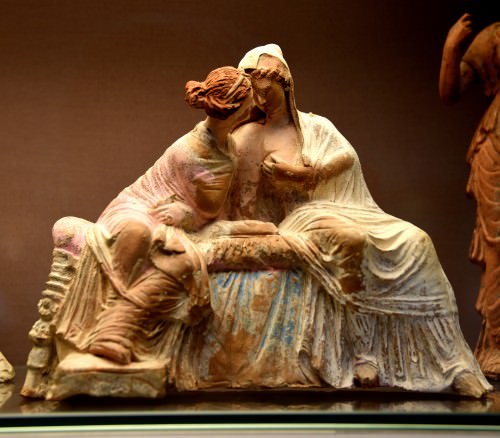
Demeter & Persephone
CLASSES
Although the male citizen had by far the best position in Greek society, there were different classes within this group. Top of the social tree were the 'best people', the aristoi. Possessing more money than everyone else, this class could provide themselves with armour, weapons, and a horse when on military campaign. The aristocrats were often split into powerful family factions or clans who controlled all of the important political positions in the polis. Their wealth came from having property and even more importantly, the best land, ie: the most fertile and the closest to the protection offered by the city walls.
A poorer, second class of citizens existed too. These were men who had land but perhaps less productive plots and situated further from the city, their property was less well-protected than the prime land nearer the city proper. The land might be so far away that the owners had to live on it rather than travel back and forth from the city. These citizens were called the periokoi(dwellers-round-about) or even worse 'dusty-feet' and they collected together for protection in small village communities, subordinate to the neighbouring city. As city populations grew and inheritances became ever more divided amongst siblings, this secondary class grew significantly.
A third group were the middle, business class. Engaged in manufacturing, trade, and commerce, these were the nouveau riche. However, the aristoi jealously guarded their privileges and political monopoly by ensuring only landowners could rise into positions of real power. However, there was some movement between classes. Some could rise through accumulating wealth and influence, others could go down a class by becoming bankrupt (which could lead to a loss of citizenship or even being enslaved). Ill-health, losing out on an inheritance, political upheavals, or war could also result in the 'best' getting their feet a little dusty.
WOMEN
Female citizens had few rights in comparison to male citizens. Unable to vote, own land, or inherit, a woman's place was in the home and her purpose in life was the rearing of children. Contact with non-family males was discouraged and women occupied their time with indoor activities such as wool-work and weaving. Spartan women were treated somewhat differently than in other states, for example, they had to do physical training (nude) like men, were permitted to own land, and could drink wine.
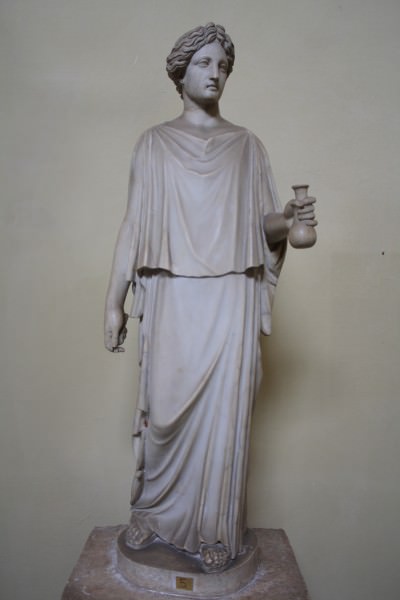
Greek Peplos Dress
Women citizens had to marry as a virgin and marriage was usually organised by the father, who chose the husband and accepted from him a dowry. If a woman had no father, then her interests (marriage prospects and property management) were looked after by a guardian ( kurios ), perhaps an uncle or other male relative. Married at the typical age of thirteen or fourteen, love had little to do with the matching of husband and wife. Of course, love may have developed between the couple but the best that might be hoped for was philia - a general friendship/love sentiment; eros, the love of desire, was to be found elsewhere, at least for the male. Marriages could be ended on three grounds. The first and most common was repudiation by the husband ( apopempsis or ekpempsis ). No reason was necessary, only the return of the dowry was expected. The second termination cause was the wife leaving the family home ( apoleipsis ) and in this case the woman's new guardian was required to act as her legal representative. This was, however, a rare occurrence and the woman's reputation in society was damaged as a result. The third ground for termination was when the bride's father asked for his daughter back ( aphairesis ), probably to offer her to another man with a more attractive dowry. This last option was only possible, however, if the wife had not had children. If a woman was left a widow, she was required to marry a close male relative in order to ensure property stayed within the family.
Women, of course, were also present in the various other non-citizen classes. The group for which we have most information is that of sex-workers. Women were here divided into two categories. The first and perhaps most common was the brothel prostitute ( pornē ). The second, was the higher-class prostitute ( hetaira ). These latter women were educated in music and culture and often formed lasting relationships with married men. It was also this class of women that entertained men (in every sense) at the celebrated symposium.
CHILDREN & ADOLESCENTS
Children of citizens attended schools where the curriculum covered reading, writing, and mathematics. After these basics were mastered, studies turned to literature (for example, Homer ), poetry, and music (especially the lyre ). Athletics was also an essential element in a young person's education. At Sparta, boys as young as seven were grouped together under the stewardship of an older youth to be toughened up with hard physical training. In Athens, young adult citizens (aged 18-20) had to perform civil and military service and their education continued with lessons in politics, rhetoric, and culture. Girls too were educated in a similar manner to boys but with a greater emphasis on dancing, gymnastics, and musical accomplishment which could be shown off in musical competitions and at religious festivals and ceremonies. The ultimate goal of a girl's education was to prepare her for her role in rearing a family.
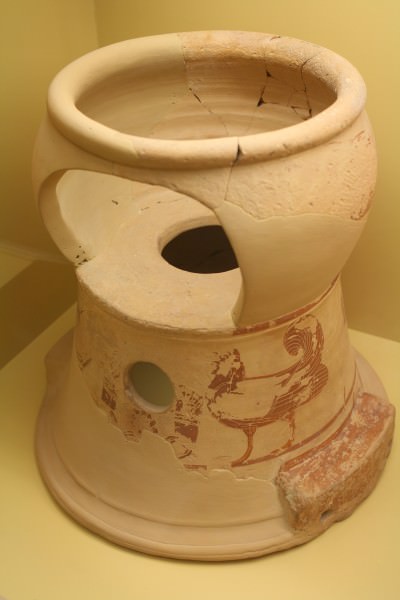
Child's Commode
An important part of a Greek youth's upbringing involved pederasty - for both boys and girls. This was a relationship between an adult and an adolescent which included sexual relations but in addition to a physical relationship, the older partner acted as a mentor to the youth and educated them through the elder's worldly and practical experience.
LABOURERS
Greek society included a significantly larger proportion of labourers than slaves. These were semi-free workers, wholly dependent on their employer. The most famous example is the helot class of Sparta. These dependents were not the property of a particular citizen - they could not be sold as a slave could - and they often lived with their families. Generally, they formed arrangements with their employer such as giving a quantity of their produce to the farm owner and keeping the rest for themselves. Sometimes the quota required may have been high or low, and there may also have been some extra benefits to the serfs such as protection and safety in numbers. However, the serf-class or helots could never achieve any real security as they were given little or no legal status and harshly treated, even killed in regular purges (especially in Sparta), in order to instil a fear which would ensure continued subordination to the ruling class. In certain periods such as war, helots were required to serve in the armed forces and, fighting well, they could even earn an escape from their lot and join the intermediary social groups which existed below the level of full-citizen and included such individuals as children with parents of mixed status (eg: father-citizen, mother- helot ).
SLAVES
In Greek society, slaves were seen as a necessary and perfectly normal part of city-life. Acquired through war and conquest, kidnap and purchase, slaves were simply amongst life's losers. There were even intellectual arguments from philosophers like Aristotle, which propounded the belief that slaves were demonstrably inferior, a product of their environment and inherited characteristics. Greeks persuaded themselves that it was they who had the best environment and characteristics and the purest bloodline and were, therefore, born to rule.
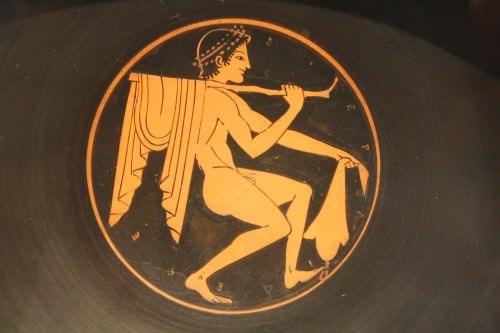
Red-figure Tondo Depicting a Youth
It is impossible to say with accuracy how many slaves ( douloi ) there were in Greek society and what proportion of the population they made up. It is unlikely, due to the costs, that every single citizen had their own slave but some citizens undoubtedly owned many slaves. Accordingly, estimates of the slave population in the Greek world range from between 15 and 40% of the total population. However, a defence speech made in a court case in Athens by Lysias, and hints from others such as Demosthenes, strongly suggest that if every citizen did not have slaves then they certainly desired them and to be a slave owner was considered a measure of social status. Slaves were not only owned by private individuals but also by the state, which used them in municipal projects such as mining or, as in the case of Athens, the police force.
The relationship between slaves and owners seems to have been much as in any other period of history with a mix of contempt, distrust, and abuse from the owners and contempt, theft, and sabotage from the enslaved. Source material is always from the viewpoint of the slave owner but there are references in literature, particularly in Greek comedy, of friendship and loyalty in at least some owner-slave relationships. Whilst the flogging of slaves is commonly referred to in Greek plays, there were also treatises written extolling the benefits of kindness and incentives in slave management.
Slaves worked in all spheres and over 200 hundred occupations have been identified. These include working in the home, in agriculture, industry workshops (eg: making shields, food, clothes and perfumes), mines, transport, retail, banking, entertainment, in the armed forces as attendants to their owner or as baggage carriers, as rowers in naval vessels or even as fighters. Farms were generally small affairs with even the richest citizens tending to own several small farms rather than one large estate, therefore, slaves were not concentrated into large groups as in later ancient societies.
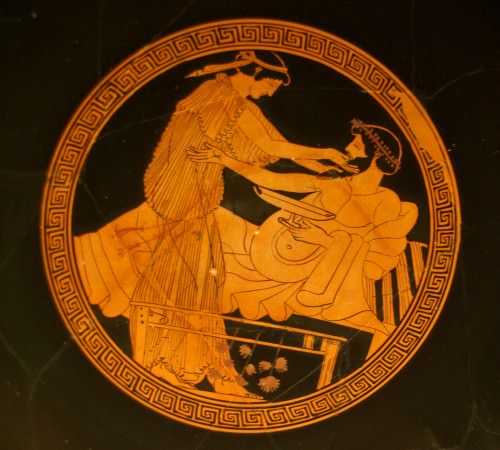
Symposiast & Hetairai
FOREIGNERS
LICENSE:
Article based on information obtained from these sources:with permission from the Website Ancient History Encyclopedia
Content is available under License Creative Commons: Attribution-NonCommercial-ShareAlike 3.0 Unported. CC-BY-NC-SA License